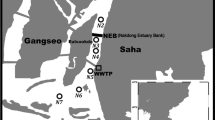Abstract
Speciation of copper in marine systems strongly influences the ability of copper to cause toxicity. Natural organic matter (NOM) contains many binding sites which provides a protective effect on copper toxicity. The purpose of this study was to characterize copper binding with NOM using fluorescence quenching techniques. Fluorescence quenching of NOM with copper was performed on nine sea water samples. The resulting stability constants and binding capacities were consistent with literature values of marine NOM, showing strong binding with \(\log K\) values from 7.64 to 10.2 and binding capacities ranging from 15 to 3110 nmol mg \({\text {C}}^{-1}.\) Free copper concentrations estimated at total dissolved copper concentrations corresponding to previously published rotifer effect concentrations, in the same nine samples, were statistically the same as the range of free copper calculated for the effect concentration in NOM-free artificial seawater. These data confirms the applicability of fluorescence spectroscopy techniques for NOM and copper speciation characterization in sea water and demonstrates that such measured speciation is consistent with the chemical principles underlying the biotic ligand model approach for bioavailability-based metals risk assessment.



Similar content being viewed by others
References
Arnold WR (2005) Effects of dissolved organic carbon on copper toxicity: implications for saltwater copper criteria. Integr Environ Assess Manag 1:34–39
Birdwell JE, Engel AS (2009) Variability in terrestrial and microbial contributions to dissolved organic matter fluorescence in Edwards Aquifer, central Texas. J Cave Karst Stud 71(2):144–156
Chadwick DB, Rivera-Duarte I, Rosen G, Wang PF, Santore RC, Ryan AC, Paquin PR, Hafner SD, Choi W (2008) Demonstration of an integrated compliance model for predicting copper fate and effects in DoD harbors. Technical report 1973. SPAWAR, Environmental Security Technology Certification Program (ESTCP) Project ER-0523
Chen W, Guguen C, Smith DS (2013) Influence of water chemistry and dissolved organic matter molecular size on copper and mercury binding determined by multiresponse fluorescence quenching. Chemosphere 92:351–359. https://doi.org/10.1016/j.chemosphere.2012.12.075
Cooper C, Tait T, Gray H, Cimprich G, Santore R, McGeer JC, Wood C, Smith DS (2014) Influence of salinity and dissolved organic carbon on acute Cu toxicity to the rotifer Brachionus plicatilis. Environ Sci Technol 48:1213–1221. https://doi.org/10.1021/es402186w
da Silva JCGE, Machado AASC, Oliveira CJS, Pinto MSSDS (1998) Fluorescence quenching of anthropogenic fulvic acids by Cu(II), Fe(III) and \(\text{UO}_{2}^{2+}\). Talanta 45:1155–1165
Di Toro D, Allen H, Bergman H, Meyer J, Paquin P, Santore R (2001) Biotic ligand model of the acute toxicity of metals. I: technical basis. Environ Toxicol Chem 20:2383–2396
El-Akl P, Smith DS, Wilkinson KJ (2015) Linking the chemical speciation of Ce to its bioavailability in water for a freshwater alga. Environ Toxicol Chem 34:1711–1719. https://doi.org/10.1002/etc.2991
Eriksen RS, Mackey DJ, van Dam R, Nowak B (2001a) Copper speciation and toxicity in Macquarie Harbour, Tasmania: an investigation using a copper ion selective electrode. Mar Chem 74:99–113
Eriksen RS, Nowak B, van Dam RA (2001b) Copper speciation and toxicity in a contaminated estuary. Technical report. Department of Sustainability, Environment, Water, Population and Communities, Canberra, Australia
Kogut MB, Voelker BM (2001) Strong copper-binding behavior of terrestrial humic substances in seawater. Environ Sci Technol 35:1149–1156
McKnight DM, Boyer EW, Westerhoff PK, Doran PT, Kulbe T, Anderson DT (2001) Spectrofluorometric characterization of dissolved organic matter for indication of precursor organic material and aromaticity. Limnol Oceanogr 46(1):38–48
Paquin PR, Gorsuch JW, Apte S, Batley GE, Bowles KC, Campbell PG, Delos CG, Toro DMD, Dwyer RL, Galvez F, Gensemer RW, Goss GG, Hogstrand C, Janssen CR, McGeer JC, Naddy RB, Playle RC, Santore RC, Schneider U, Stubblefield WA, Wood CM, Wu KB (2002) The biotic ligand model: a historical overview. Comp Biochem Physiol Part C 133:3–35
Playle R, Dixon D, Burnison K (1993) Copper and cadmium binding to fish gills: Estimates of metal-gill stability constants and modeling of metal accumulation. Can J Fish Aquat Sci 50:2678–2687
Ryan DK, Weber JH (1982) Fluorescence quenching titration for determination of complexing capacities and stability constants of fulvic acid. Anal Chem 54:986–990
Santore R, DiToro D, Paquin P, Allen H, Meyer J (2001) Biotic ligand model of the acute toxicity of metals II: Application to acute copper toxicity in freshwater fish and Daphnia. Environ Toxicol Chem 20:2397–2402
Smith DS, Kramer JR (2000) Multi-site metal binding to fulvic acid determined using multiresponse fluorescence. Anal Chim Acta 416:211–220
Smith DS, Bell RA, Kramer JR (2002) Metal speciation in natural waters with emphasis on reduced sulfur groups as strong metal binding sites. Comp Biochem Physiol Part C 133:65–74
Sunda WG, Hanson P (1979) Chemical modeling in aqueous systems, American Chemical Society, Washington D.C., chap Chemical speciation of copper in river water, pp 147–180. ACS Symposium Series
Tait TN (2013) Determination of copper speciation, bioavailability and toxicity in saltwater environments. MS Thesis, Wilfrid Laurier University. http://scholars.wlu.ca/etd/1615. Accessed 15 Dec 2017
Tait TN, Rabson LM, Diamond RL, Cooper CA, McGeer JC, Smith DS (2015) Determination of cupric ion concentrations in marine waters: an improved procedure and comparison with other speciation methods. Env Chem 13:140–148. https://doi.org/10.1071/EN14190
Tait TN, Cooper CA, McGeer JC, Wood CM, Smith DS (2016) Influence of dissolved organic matter (dom) source on copper speciation and toxicity to Brachionus plicatilis. Env Chem 13:496–506. https://doi.org/10.1071/EN15123
US EPA (2007) Aquatic life ambient freshwater quality criteria - Copper. Tech. Rep. EPA-822-R-07-001, Office of Water, Washington, D.C
Wu F, Tanoue E (2001) Isolation and partial characterization of dissolved copper-complexing ligands in streamwaters. Environ Sci Technol 35:3646–3652
Acknowledgements
This work was supported by an NSERC CRD Grant (Scott Smith, P.I.) with co-funding from the International Zinc Association (IZA), the International Lead Zinc Research Organization (ILZRO), the Nickel Producers Environmental Research Association (NiPERA), the International Copper Association (ICA), the Copper Development Association (CDA), Teck Resources, and Vale.
Author information
Authors and Affiliations
Corresponding author
Rights and permissions
About this article
Cite this article
Tait, T.N., McGeer, J.C. & Smith, D.S. Testing the Underlying Chemical Principles of the Biotic Ligand Model (BLM) to Marine Copper Systems: Measuring Copper Speciation Using Fluorescence Quenching. Bull Environ Contam Toxicol 100, 76–81 (2018). https://doi.org/10.1007/s00128-017-2262-8
Received:
Accepted:
Published:
Issue Date:
DOI: https://doi.org/10.1007/s00128-017-2262-8




